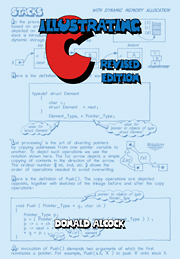Summary
This chapter defines most of the basic components of C. Their syntax is defined using a pictorial notation. Characters, names and constants (the simple building blocks) are defined first. Important principles of the language are next explained; these include the concept of scalar ‘types’, the precedence and associativity of ‘operators’, the concepts of ‘coercion’ and ‘promotion’ in expressions of mixed type.
The operators are summarized on a single page for ease or reference.
The syntax of expressions and statements is defined in this chapter. Declarations are discussed, but their syntax is not defined because it involves the concept of pointers and dynamic storage. These topics are left to later chapters.
NOTATION
For a precise definition of the syntax of ANSI C, see the definitions in NSI X 3.159. These are expressed in BNF (Backus Naur Form).
To appreciate the syntactical form of an entity the practical programmer needs something different; BNF is not a self evident notation. Some books employ railway track diagrams, potentially easier to comprehend than BNF, but the tracks grow too complicated for defining structures in C. So I have devised a pictorial notation from which a programmer should be able to appreciate syntactical forms at a glance. The notation is fairly rigorous but needs a little help from notes here and there.
Information
- Type
- Chapter
- Information
- Illustrating C , pp. 27 - 50Publisher: Cambridge University PressPrint publication year: 1994
